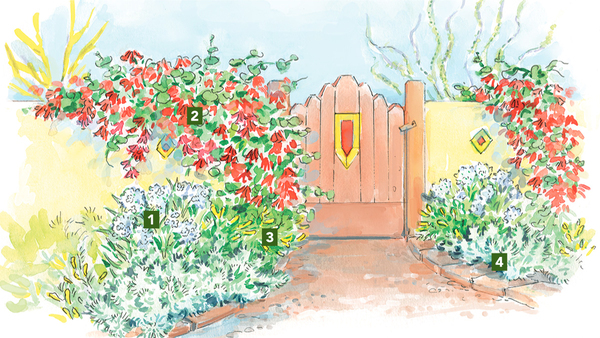
In her article “Spring Planting Ideas,” Michelle Gervais beautifully illustrates the magical time that is the start of spring: “Our winter-weary spirits lift as hints of green begin to appear. We notice even the smallest patches of snowdrops and crocuses as we drive by at 55 miles per hour. The first daffodil sighting is a thrill, and tulips are almost too colorful to bear. The pale chartreuse haze in the trees seems to change to lush, vibrant green overnight, and every new sprout brings delight. It’s the start of another exciting season, and the potential and possibilities for our gardens seem boundless.”
While spring is often a flurry of planting, planning, and performing the many garden chores in between, it’s always a treat to have some plants that will kick off the season with color while others are still waking up and waiting for warmer weather to show off their best. This spring planting plan was crafted by regional expert Loree Bohl and would be a spectacular addition to any Pacific Northwest garden.
1. Beaked yucca

Name: Yucca rostrata
Zones: 5–10
Size: 4 to 10 feet tall and 3 to 5 feet wide
Conditions: Full sun to partial shade; average to dry soil
Native range: Southern Texas, northern Mexico
I fell for this tall, spiky species while visiting the desert Southwest and was thrilled to learn it would grow in my Portland garden. With its trunking habit, it reads as an exclamation point in the landscape, and each specimen has a unique personality. Like a grass, the long strappy leaves move with the wind. As the plant grows, the older leaves brown and fold down toward the trunk. If left in place the dried foliage will eventually form a skirt, but it can be removed with no effect on the plant’s hardiness. Beaked yucca rarely blooms; I have grown it for over 15 years and my plants have never produced a single spike. It appreciates summer water but does fine in our summer-dry region.
2. Whale’s tongue agave

Name: Agave ovatifolia
Zones: 7b–10
Size: 3 feet tall and 5 feet wide
Conditions: Full sun; well-drained soil
Native range: Mexico
This truly remarkable statement plant is one of the best agaves for Pacific Northwest gardens, since it doesn’t seem fazed by our winter moisture. It rarely offsets, so it won’t become crowded by babies at its feet. You won’t get free plants, but you’ll get no wounds from trying to remove them either. As with all agaves, good drainage is key. Whale’s tongue agave appreciates being planted higher than the surrounding soil, and on a slope if possible. Plant in spring to give a new specimen the entire growing season to become established before winter. A little supplemental water in summer speeds growth. As is the case with most agaves, there is only one spectacular bloom, and then the plant slowly dies. Bulbils or seeds may form on the expired plant’s bloom spike.
3. Upright myrtle spurge

Name: Euphorbia rigida
Zones: 7–10
Size: 1 foot tall and 2 feet wide
Conditions: Full sun; dry to average, well-drained soil
Native range: Southern Europe, southwestern Asia
While its vivid chartreuse blooms are a sure sign that spring has arrived, this spurge has something to offer in every season. Its evergreen blue-green foliage is arranged along the stems in a mesmerizing symmetrical pattern. The ends of the upright, curved stems develop a pink blush in late winter, and several interesting changes follow. The early spring flowers are followed by a mid-spring display of seed capsules backed by coral-colored bracts. Be aware that the ripe seed capsules are capable of casting seed far and wide. Some years I let them do their thing so I will have plants to share, but most often I cut back the bloomed-out stalks before the seeds disperse. Use caution when planting and cutting it back, as the milky sap can cause skin irritation.
4. Chinese mahonia

Name: Mahonia gracilipes
Zones: 7–8
Size: 4 to 5 feet tall and wide
Conditions: Full sun to full shade; moist, well-drained soil
Native range: China
I can’t see this plant without remembering a garden visitor who found he could rub the white coating off the back of the leaves and then shared his discovery with others. Needless to say, this horticultural vandalism was not appreciated! Irresistible foliage is just one of the cool features of this bold, open, airy shrub. Its leaflets are larger than those of most other mahonias, and it has stunning, reddish new growth in early spring. In late summer it produces multiple sprays of tiny yellow and pink flowers held on thin stems that darken to an intense fuchsia when the purple-to-blue berries appear. Spring is the best time of year to get it established and watered in. With occasional supplemental water, it does fine in our region’s dry summers.
Loree Bohl is a lover of spiky plants, the creator of the Danger Garden blog, and the author of Fearless Gardening: Be Bold, Break the Rules, and Grow What You Love.
View the full collection of regional planting plans and see the rest of issue 216.
Fine Gardening Recommended Products

Scotts Cordless Grass-Shear/Shrub-Trimmer Combo
Fine Gardening receives a commission for items purchased through links on this site, including Amazon Associates and other affiliate advertising programs.
- 13.5 x 3 x 5 inches
- Uses a 7.2-Volt 2Ah high-capacity built-in lithium-ion battery; Includes a fast charger

Buffalo-Style Gardens: Create a Quirky, One-of-a-Kind Private Garden with Eye-Catching Designs
Fine Gardening receives a commission for items purchased through links on this site, including Amazon Associates and other affiliate advertising programs.



















Comments
Log in or create an account to post a comment.
Sign up Log in